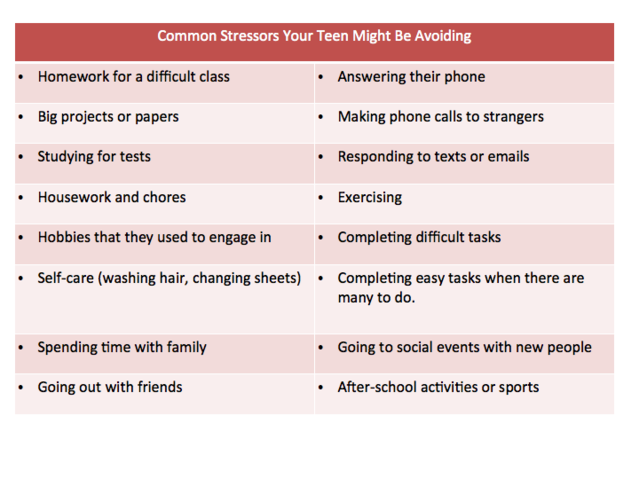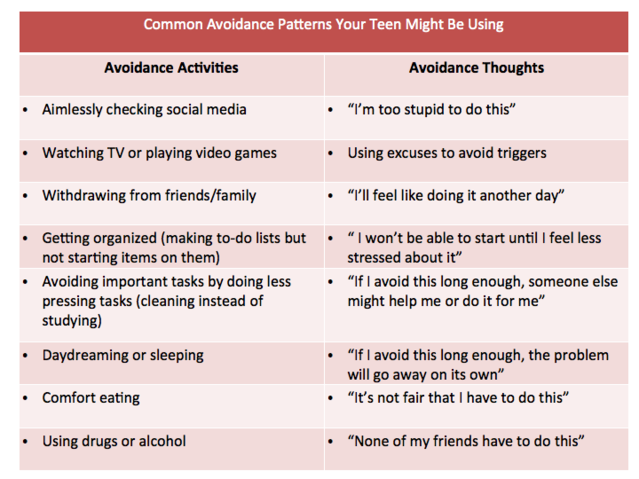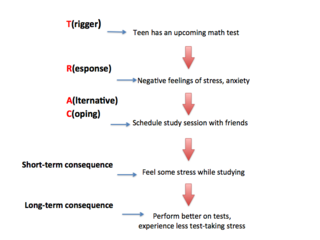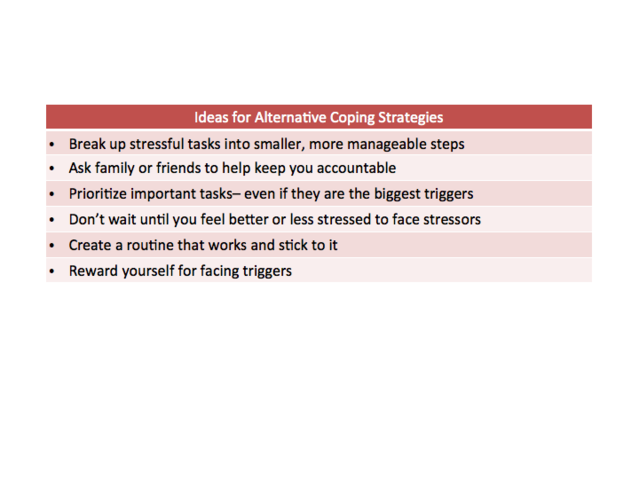Adolescence
Is Your Teen In a Stress TRAP?
New research can help you get them back on TRAC.
Posted April 22, 2019

This guest post was contributed by Yana Ryjova, a graduate student in the USC Psychology Department's Clinical Science program.
Everyone experiences stress, and teens are not immune.
When teens are stressed, anxious, or feeling down, it is common for them to avoid whatever is causing the negative emotions. Unfortunately, while avoidance helps them cope in the short term, it can cause more problems and even worse feelings in the long run. As a parent, you can help your teen avoid this TRAP and get back on TRAC!
The following strategies and ideas are based an evidence-based psychotherapy known as Behavioral Activation (Chambless & Hollon, 1998). Research published in reputable scientific journals, such as Clinical Psychology Review, have found that this approach is an effective treatment for depression (Cuijpers et al., 2007; Ekers et al., 2008). The basic principle of Behavioral Activation is that what we do (or don’t do) is connected to how we feel. Put simply, Behavioral Activation works by decreasing avoidance and increasing engagement in pleasant activities to help people feel better. (If you want to learn more about how to help yourself or your teen using Behavioral Activation, please visit this site or consider purchasing “Activating Happiness: A Jump-Start Guide to Overcoming Low Motivation, Depression, or Just Feeling Stuck,” a self-help book written by Drs. Hershenberg and Goldfried.)
What is the TRAP?
TRAP stands for:
T: Trigger
R: Response
AP: Avoidance Pattern
When your teen is under a lot of stress, you may notice them begin to avoid certain activities that cause these high levels of stress. For example, maybe you've noticed them binging Netflix, texting friends, even cleaning their room to escape studying for a math test. Maybe you’ve suspected that they pretended to be sick to get out of going to a social event or party. The fact that teens avoid these “triggers” makes a lot of sense. Avoiding feelings of stress and anxiety feels a lot better than confronting stress directly! When teens avoid behaviors, they don’t have to experience the negative feelings that come with them. Because it feels so good to put off studying and stressful social events, you may find that avoiding one or two triggers leads to your teen avoiding even more activities and responsibilities. This is one of the biggest problems with avoidance. Another issue involves the long-term consequences of avoidance. While it may feel good temporarily to avoid studying, it can lead to far more stressful consequences, such as failing the math test.
This pattern of avoidance is the TRAP that teens can fall into.
Use the following steps to identify that TRAP and to help your teen get back on TRAC.
Step 1: Assess avoidance triggers with your teen
Triggers are the situations that your teen experiences that lead them to use avoidance behaviors. Everyone has different triggers, but the following list can help you and your teen start to identify problem areas that cause them to withdraw, procrastinate, and avoid.

Step 2: Talk to your teen about how their triggers make them feel
It may feel tempting to tell your teen things like, “just do it, it’s not that hard,” or “there is no need to feel stressed about this,” when discussing their triggers. However, statements like this may cause your teen to shut down, shut you out, and feel even more stressed.
The fact of the matter is that teens often use avoidance to escape some pretty difficult feelings. Their triggers may make them feel a lot of pressure or anxiety. They may feel very stressed, afraid, or so overwhelmed that even activities that seem simple to you, like opening the textbook to study, are not so simple for them.
When talking to your teen, work towards really understanding their feelings in response to triggers. Convey your support, remember to listen, and gently help them figure out what situations make them feel like avoiding.
Step 3: Work with your teen to figure out their avoidance patterns

Once you and your teen identify triggers and talk about how those triggers make them feel, work towards understanding what their avoidance patterns are. There are many ways your teen might be avoiding. For example, your teen might avoid homework by watching hours of TV, or avoid social events by making excuses for why they cannot attend.
Use the following list to identify common avoidance patterns, and talk with your teen to identify other ways in which they avoid their triggers.

Step 4: Getting back on TRAC
TRAC stands for:
T: Trigger
R: Response
AC: Alternative Coping
Getting back on TRAC is not about removing triggers, or changing your teen’s responses to them. It is about using alternative coping strategies to avoid the long-term difficulties of avoidance. Instead of avoidance, getting back on TRAC involves helping your teen take steps to face their triggers to feel better in the long run.
Ask your teen about:

The long-term consequences of avoiding their triggers.
Their goals and values—is avoiding keeping them from reaching their goals?
How they would feel if they didn’t avoid their triggers. How would they feel in the process of facing a trigger? How would they feel if they overcame that stressor?
Ideas about what they could do instead of avoiding.
Although this is sometimes easier said than done, identifying alternative coping strategies is a great way to help your teen face stressful situations and avoid avoidance. Use the following list for some ideas, but work with your teen to figure out what strategies would work best for them.

Step 5: Try out alternative coping strategies, review progress, and never give up!
Once you and your teen have identified some ideas for alternative coping strategies, encourage your teen to try them out. Remember, it may be very difficult for them at first, so offer praise when they face their triggers, support when they struggle to implement alternative coping strategies, and help them find what works for them.
As they try out new strategies, check in and talk about them. Discuss how it felt not avoiding their trigger, how it felt to use an alternative coping strategy, and how they felt about the outcome, whether successful or not. When strategies do not work well, gently push your teen to try new strategies. When they do work, offer praise and talk about how to implement that strategy regularly.
Most importantly, never give up! Your teen will face stressors throughout their entire life. You can make a difference by teaching your teen how to face their stress, even when it feels really scary and difficult to do so. By working on these skills together, you can model how to face stress effectively, and teach your child skills that will prepare them for anything that comes their way!
What to do if your teen is struggling more seriously with stress, anxiety, or depression?
Although you can help your teen if they are dealing with everyday stress, it may be appropriate to contact a professional if you are concerned that your child’s stress or anxiety is more serious.
First, remember that there is nothing wrong with you as a parent if you can’t help your teen with these feelings. In fact, by considering getting them professional help, you are being a great parent who clearly cares about your child’s safety and well-being.
Find a licensed professional in your area by going to Psychology Today's therapist finder and typing in your city or zip code. I recommend looking for a therapist that accepts your insurance, and who specializes in working with teens or families.
References
Cuijpers, P., Van Straten, A., & Warmerdam, L. (2007). Behavioral activation treatments of depression: A meta-analysis. Clinical psychology review, 27(3), 318-326.
Ekers, D. and Richards, D. and Gilbody, S. (2008) 'A meta analysis of randomised trials of behavioural treatment of depression.', Psychological medicine., 38 (5). pp. 611-623.
Hershenberg, R., & Goldfried, M. R. (2019). Activating happiness: A jump-start guide to overcoming low motivation, depression, or just feeling stuck. Strawberry Hills, NSW: ReadHowYouWant.




